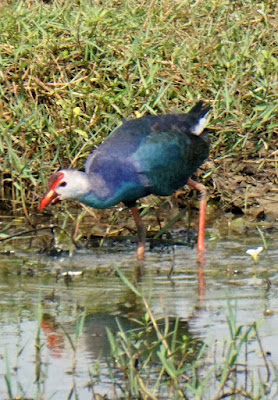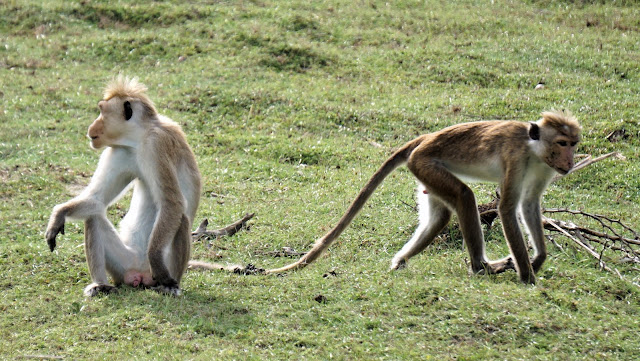After multiple trips into Yala National Park (three for Bob, two for me), it was time to move on. We returned to the hotel and had lunch, then packed up for our final safari at Bundala National Park, a one-hour drive away.
Honestly, by this time I was pretty tired of driving along dusty, bumpy roads looking at/for the same animals we'd already seen everywhere else. This was to be our sixth half-day safari drive (although I skipped #4), and wasn't too thrilled with the thought of another.
Bob, on the other hand, could have keep going for days.
And so on we went to Bundala National Park, situated on the Indian Ocean and the smallest of the four national parks we visited--just 13 square miles.
One of our first sightings was a purple heron, the bird version of a giraffe:
The ubiquitous painted stork started a string of colorful birds:
These grey-headed swamphens have rather dull heads attached to iridescent aquamarine and navy blue bodies that change colors like a hologram, depending on the angle. Why weren't they named for their exquisite plumage rather than their dull heads?
There is nothing common about the common kingfisher, which has a highly-polished metallic sheen:
My favorite, the bee-eater, was also present:
A grey heron and two whistling ducks in a stand-off:
An Indian boar seems out of place among all this delicate beauty:
A spoonbill with its bizarre bill:
Here's a little flora to go with all the fauna. Doesn't it look like prickly pear cactus?
Later in the drive we saw an entire troop of langur monkeys:


Ah - ah - ah - ah - CHOO!
No, Billy Bob and Jimmy Lee, don't sit on that post! The neighbors might see you!
Well, we're back to birds again. This yellow-billed lapwing appeared to be nesting on the ground:
The ever-unpopular peacock (at least with the Sri Lankans) was, as usual, demanding attention and getting in the way:
This rose-ringed parakeet kept poking its head into a hole in a tree trunk:
Okay, now this is cool! Two birds with what must be eggs or hatchlings inside that hole in the tree!
I wish I could take a peek:
The angular necks of oriental darters are bizarre:
"Never smile at a crocodile," especially one with his mouth open waiting to eat you. This is a saltwater croc, different than the mugger crocs we saw in other parks:
An Indian stone curlew looks a bit like the Lone Ranger:
Black-winged stilts have orangish-red legs:
Eventually we came to a point that looked out over the sapphire waters of the Indian Ocean:
Several white-bellied sea eagles--enormous birds--were taking advantage of the air currents overhead, never flapping their wings and yet soaring like kites above the water. The birds were ethereal, almost other-worldly. It was another National Geographic Experience.
Yeah, don't tell Bob, but I guess I could go on more safaris.
Heading out of the park, we spotted a crested hawk eagle:
. . . and a really cute Indian star tortoise
. . . making its way, ever so slowly . . .
. . . into the shrubbery:
I could relate. I was feeling a bit sluggish myself.
Honestly, by this time I was pretty tired of driving along dusty, bumpy roads looking at/for the same animals we'd already seen everywhere else. This was to be our sixth half-day safari drive (although I skipped #4), and wasn't too thrilled with the thought of another.
Bob, on the other hand, could have keep going for days.
And so on we went to Bundala National Park, situated on the Indian Ocean and the smallest of the four national parks we visited--just 13 square miles.
In 2005, UNESCO declared these wetlands to be a Man & Biosphere Reserve. The focus of the park is definitely on birds, although we saw other animals, including one lonely elephant.
It was very different from the other national parks we had visited--flat and open and marshy:
One of our first sightings was a purple heron, the bird version of a giraffe:
The ubiquitous painted stork started a string of colorful birds:
The egret looks a bit dowdy in comparison:
We also spotted its less flashy cousin, the pied kingfisher:
My favorite, the bee-eater, was also present:
A soft-shell turtle getting a tan:
A spoonbill with its bizarre bill:
Yay! Some langur monkeys! (I was getting tired of birds.)

There were lots of mothers with babies:
This mom looked like she'd had a long day. Her baby was crawling all over her, demanding attention, and she must have been ready for him to just take a nap:
I love the langurs with their solemn dark faces surrounded by a halo of fur:
They are a real classy bunch:

On the opposite end of the class spectrum are the macaques, who remind me of the poor hillbilly relations you hope never come to visit:
Ah - ah - ah - ah - CHOO!
No, Billy Bob and Jimmy Lee, don't sit on that post! The neighbors might see you!
All the hairstylin' in the world isn't going to fix that mop. Perhaps this is Trump's stylist at work:
Well, we're back to birds again. This yellow-billed lapwing appeared to be nesting on the ground:
The ever-unpopular peacock (at least with the Sri Lankans) was, as usual, demanding attention and getting in the way:
I tried hard to despise them as much as Sanjay did, but I just couldn't:
Okay, now this is cool! Two birds with what must be eggs or hatchlings inside that hole in the tree!
This was the final elephant sighting of the trip. According to my count, he was #163:
"Never smile at a crocodile," especially one with his mouth open waiting to eat you. This is a saltwater croc, different than the mugger crocs we saw in other parks:
An Indian stone curlew looks a bit like the Lone Ranger:
Several white-bellied sea eagles--enormous birds--were taking advantage of the air currents overhead, never flapping their wings and yet soaring like kites above the water. The birds were ethereal, almost other-worldly. It was another National Geographic Experience.
Okay, I have to admit it. These views made the bouncing and swaying over those rutted dirt roads totally worth it:
Yeah, don't tell Bob, but I guess I could go on more safaris.
Heading out of the park, we spotted a crested hawk eagle:
. . . and a really cute Indian star tortoise
. . . into the shrubbery:
I could relate. I was feeling a bit sluggish myself.























































So much to see! I love (again) all the colors, and all those monkeys/macaques.
ReplyDeleteWe saw more distinct species of wildlife in Bundala than any of the other national parks. It was also most diverse in in its landscape. So in some respects, I liked it the most of the national parks. However, it also lacked the sense of wildness that some of the other parks had. I have mixed feelings about the park, but was very happy we went.
ReplyDelete